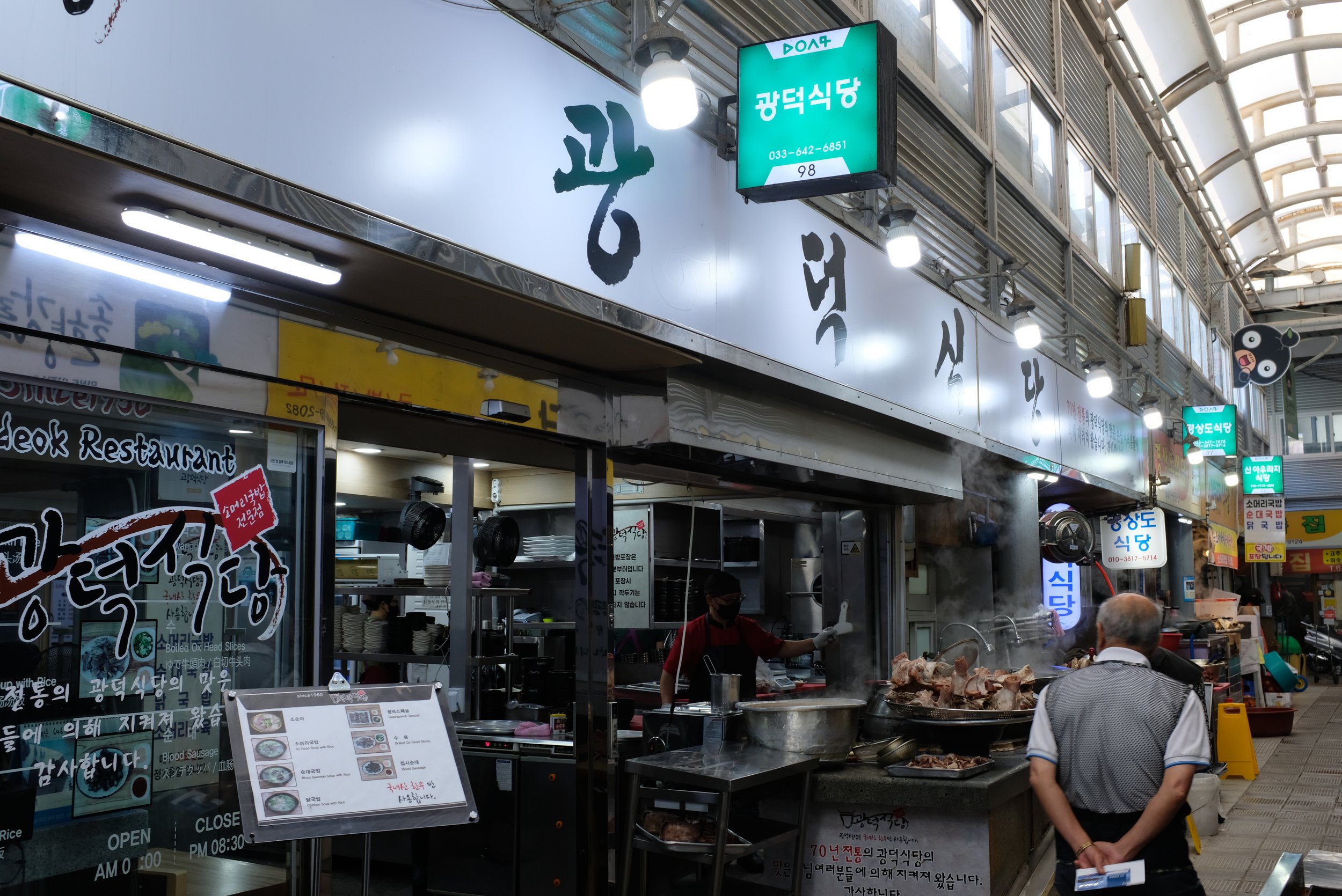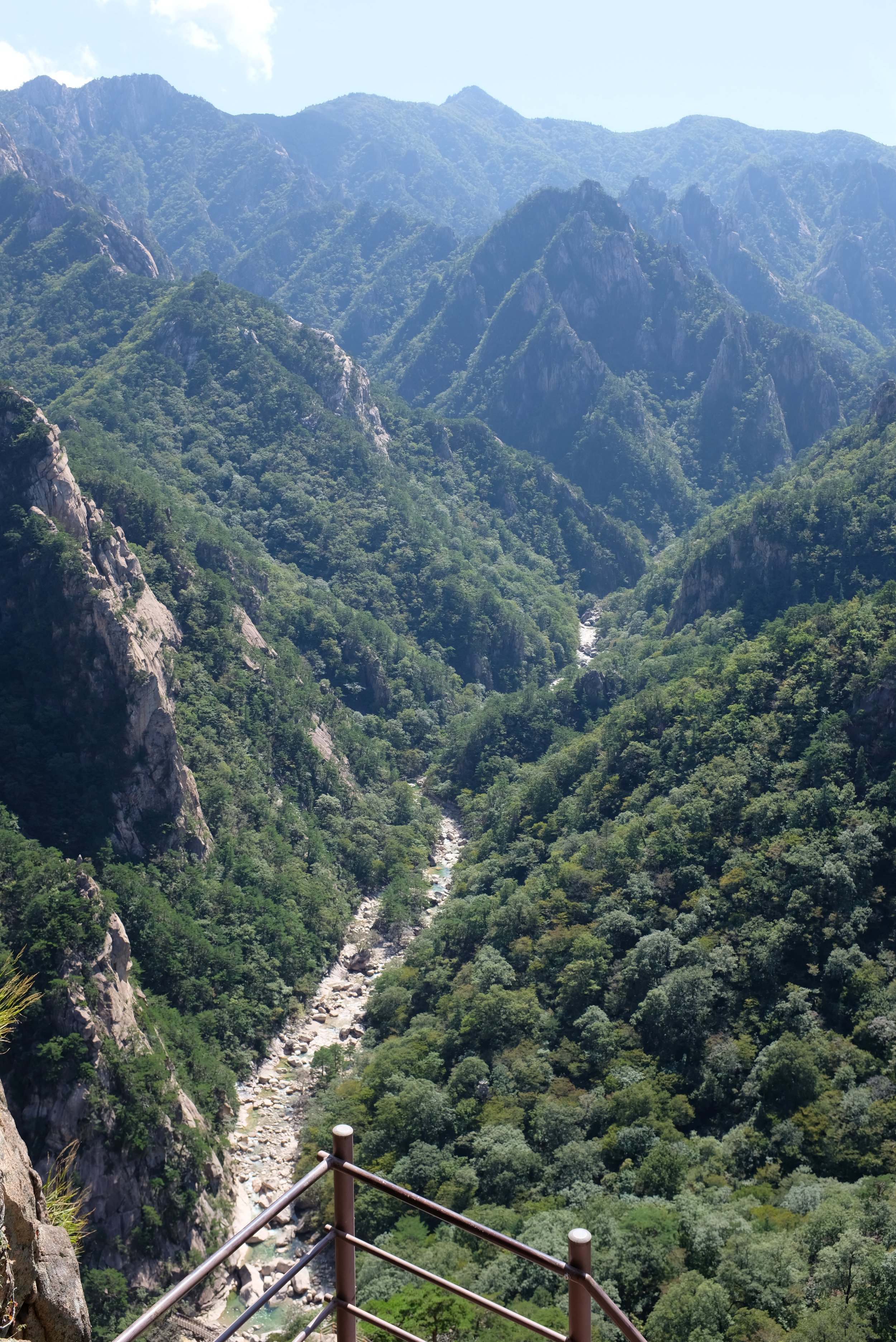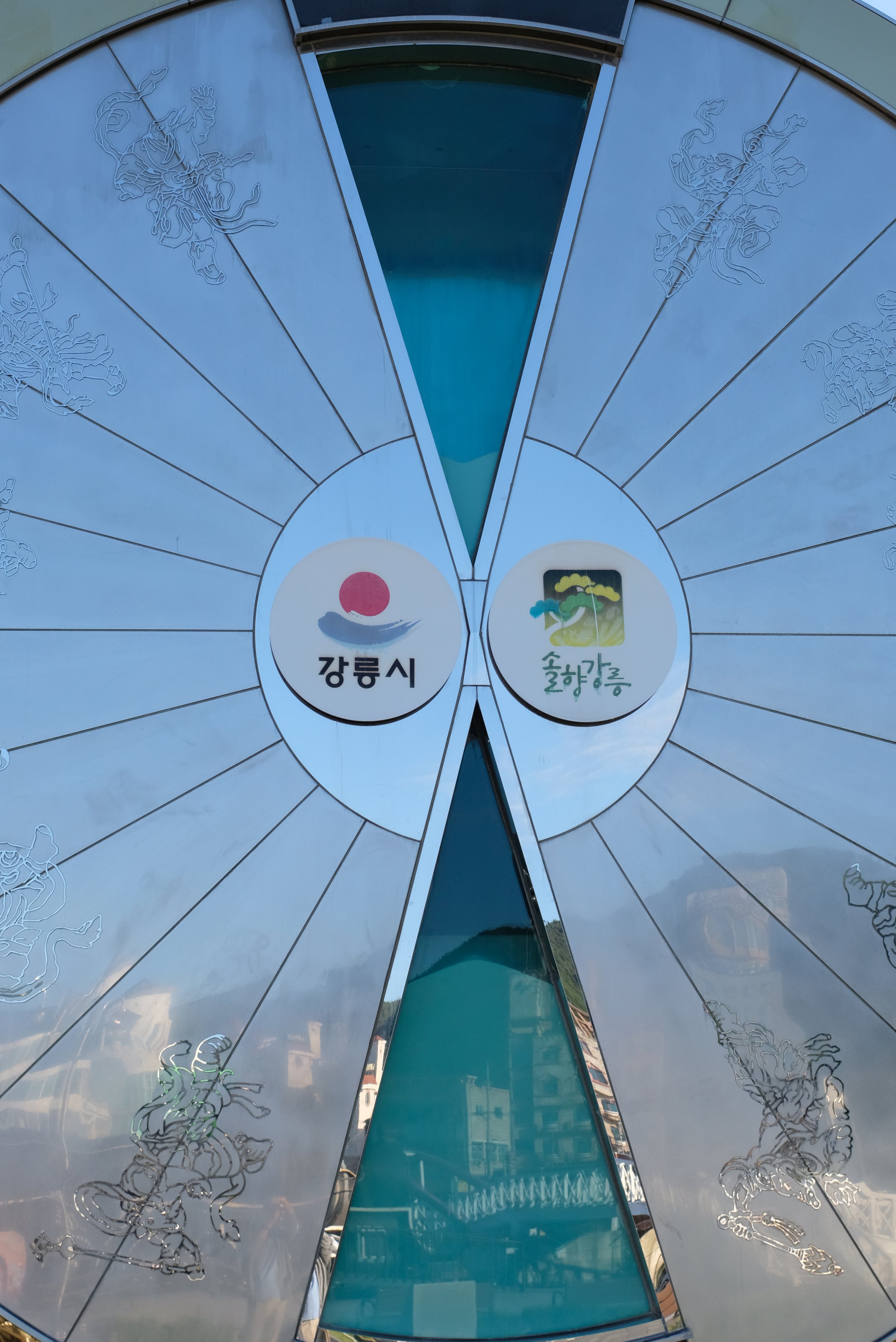Korea Trip 2022: Farewell to the Northeast
September 22






I’m a national park junkie. I’ve visited several in the U.S. over the years, and they’re a big part of why I’ve been going on yearly road trips. That said, considering that there’s one in Sokcho, I absolutely had to include it in my itinerary. That park is 설악산 (Seoraksan National Park) | Naver link, and its namesake is the third highest mountain in South Korea. There are several parts to Seoraksan: 내서락 (Inner Seorak) in the northwest, the south’s 남서락 (South Seorak), and finally, 외설악 (Outer Seorak), where I would be. From my Airbnb, it took about 20-25 minutes to drive there. Parking cost ₩6,000 (estimated $4.22), and admission cost ₩4,500 (estimated $3.16). Even from the ground, I got a pretty cool view of the mountain range here, and it was only going to get better.









I was thinking about doing two major and intensive hikes, and the trails for both are near 신흥사 (Sinheungsa) | Naver link, so that was my first stop at the park. Just outside of the temple walls is 통일대불 (Great Unification Buddha), a massive Buddha statue. It’s impressive to look at, and I saw plenty of visitors stop and bow to it. Equally impressive are the temple’s buildings and contents. They’re so vivid in color that I couldn’t help but appreciate them - not just as historical artifacts, but as works of art. Going around not just the temple grounds, but the entire park, I would see tons of stacked stones, which are a form of Buddhist devotion and prayer.








There’s no shortage of hikes at Seoraksan, but there was one I’ve been wanting to do for a long time: the steep climb up to 금강굴 (Geumganggul) | Naver link, a cave on the side of a mountain that’s also a Buddhist place of worship. The trail to it initially leads to 비선대계곡 (Biseondae Rock) | Naver link, which is about 2.3 kilometers. The first 1.5 kilometers is quite easy, but soon the trail becomes a series of rocks the closer I got to Biseondae Rock. Hiking on rocks isn’t difficult per say, but it did start to take a toll on the knees and ankles the longer I kept at it. The trail does run next to a large stream, which comforted me since I knew I would be near water. The trail’s rocks do get interrupted by some stairs as well as a couple bridges, and once I got to a rather large bridge, I knew I was at Biseondae Rock. Located right in the middle of a valley, its scale is wondrous to behold. Though my mind was focused on the cave, I still took a moment to take in what I saw before me.









The trail from Biseondae Rock up to the cave isn’t long at 0.6 kilometers, but it’s absolutely taxing, as it’s 90% rocks and all incline. Many of these rock steps barely have enough space, so I had to walk sideways at times. After about 20 minutes, I reached my first flight of stairs, and considering how steep they are, I had to tell myself to not look down often (I have a fear of heights). It’s quite amazing at how well the trail of rocks and stairs hold together, as they seemed like they’ve been in place for a while and exposed to the natural elements. I was anxious about whether the stairs could hold my weight, so any small creak made me stop and take deep breaths. Eventually, two flights of stairs (built into the side of the mountain) later, I reached the cave. Deep into the cave was the place of worship, and there was a monk there, chanting and praying. There are signs requesting that visitors be silent, so I quietly moved about to take photos. After about 10 minutes, the monk addressed me, but I couldn’t quite hear what he said, so I sheepishly packed up my things to start making my way down, thinking that I probably annoyed him by not praying or buying religious items. On the way down, there’s a spot converted into some kind of observation deck with an incredibly majestic view of the mountain range. I stayed there for a while to take some photos and rest, and I was surprised to see that my phone had decent data coverage and reception - which is a testament to Korea’s network quality and range. As I was about to leave, a woman in her late 40s or early 50s asked me if the cave really was at the top of the last two flights of stairs. I answered affirmatively, and she decided not to go up to the height due to her fear of heights. She accompanied me on our trek back down, and we chatted about the park (she comes here about once or twice a year), with her giving me some recommendations. Upon returning to Sinheungsa Temple, we parted ways.
I had yet to eat anything that day up until that point, and it was past 1:30pm. While I was indeed exhausted, I knew I didn’t want to leave yet, but I did need lunch. The park has a handful of restaurants near the temple, and for the most part, they seemed to serve the same (and overpriced, in my opinion) dishes. After assessing my options, I headed over to 권금성휴게소 (Gwongeumseong Rest Area) | Naver link since its outdoor tables were under plenty of shade. I ordered the 산채비빔밥 (mountain vegetable bibimbap) for ₩9,000 ($6.49), as I figured this dish wouldn’t feel like such a gut bomb after eating. The bibimbap had a decent amount of greens and a lot of mushrooms, and after squirting some 고추장 (gochujang - red chili paste) over it, I mixed everything up and then again after throwing in the soybean sprout banchan. The dish really hit the spot and energized me.











My recent companion had told me that 비룡폭포 (Biryong Falls) | Naver link is one of her favorite spots in the park and an absolute must-visit, so after checking its distance on the map (about 1.7 kilometers), I started making my way there. Like the trail up to the Biseondae Rock, the trail here starts off being quite easy before it too starts to give way to rocks as well as stairs. I made sure to take brief breaks every now and then, as I was could sense my knees protesting every time I took a step upward. There’s actually another waterfall(s) on the way up to Biryong Falls, which is 육담폭포 (Yukdam Falls) | Naver link. There are a series of bridges to cross, and from there, they became prime spots to take some pretty great photos of the falls. From Yukdam Falls, Biryong Falls is about another 15 minutes ahead, and it’s all incline; at least this one didn’t kick my fear of heights into full gear. Soon, I arrived at Biryong Falls, and to be quite honest, I didn’t think it’s as impressive at Yukdam Falls, as Biryong Falls is smaller in comparison, though I suppose it’s in a more “serene” area. The trail does continue up to another waterfall, but by then, I didn’t want to go up any more inclines. I turned around and made my way back. The hike in total (round trip) took about an hour and half.







I had time to squeeze in one more activity, so I opted to take the 설악 케이블카 (Seoraksan Cable Car) | Naver link up to 권금성 (Gwongeumseong Fortress) | Naver link, located near the top of one of the mountains. Adult tickets for the cable car cost ₩13,000 ($9.37), and they’re all round trips. This is probably one of the most popular activities to do in the park, and soon I was ascending to the mountains in the cable car with about 20 other people. The trip up takes about three or four minutes, and it’s quite smooth and offers some spectacular views of not only the park’s mountains, but also the coastal cities (including Sokcho) in the distance. Once at the top, I headed down a path and climbed a couple flights of stairs to reach Gwongeumseong Fortress, which isn’t really a fortress - at least, not a standing one. This site actually contains ruins of the fortress and really just serves as a good opportunity for visitors to scale some rocks and take photos of not only themselves and their loved ones, but also their surroundings. My knees groaned as I climbed up some rocks to see what was around, but I didn’t stay long, eventually returning to the cable car and descending back down into the valley. I departed from the park immediately after, feeling nothing just exhaustion.




Back in Sokcho, I had remembered passing by an interesting-looking pizza joint called 갯배피자 (Getbae Pizza) | Naver link during my first night in the area, so I walked over there. It’s two stories tall and contains wide open windows, allowing for terrific air flow. I was asked to look around and select a table (and its number) for ordering, so I took a spot on the second floor, came back down, and ordered a bacon cheddar jalapeño pizza as well as a glass of Goose Island beer for ₩30,000 ($21.62). A server dropped off the beer as well as some pickled vegetables, and my God, the beer was absolutely what I wanted after that day’s strenuous hikes. While the pizza seemed a little oily when it came out, it was quite delicious, and I dug into it ravenously. To my surprise, I was able to finish the whole pie - the diameter was about 16 inches? - in one sitting (minus a couple crusts). With my stomach feeling quite content (okay, a little bloated too), I headed back to my Airbnb to pack and bring my final night in Sokcho to a close.
September 23









I wanted to watch the sun rise before I left Gangwon-do, and 모래시계 공원 (Sandglass Park) | Naver link back in Gangneung seemed like a great place to do so. Unfortunately, not only did I leave about a half hour later than anticipated, I underestimated how long the drive down would take, as the park is located further south from the places I had been to in the city a few days prior. While I missed the sunrise, morning at the park was quite nice, with only a handful of people out and about. The park’s most well-known feature is the giant hourglass in its center, which represents the Korean’s yearning for a better future. I especially liked its design and the thought that went into it. The park is also home to a rail bike system as well as a time museum that’s made of a train and several cars. Unfortunately, these weren’t open yet, and I didn’t have the time to wait, so after taking a lap around the park, I left to head deeper into Gangneung.








Gangneung is a great city to get coffee, and I had heard great things about 테라로사 레스토랑 강릉본점 (Terarosa Restaurant Gangneung Main Branch) | Naver link, so that was my next stop. As it turns out, this location is comprised of not only a cafe, but also a small museum as well as a restaurant. I was planning to get breakfast right after, so all I wanted was a cup of hot coffee as well as a bag of coffee beans to gift a friend. For my coffee, I ordered a mug of their hand rip coffee, specifically the 단풍 블렌드 (Fall Foliage Blend), which has hints of maple syrup, dates, pecans, and figs. While waiting for my order, I walked around the cafe’s spaces, and this place is massive. There’s no shortage of tables and chairs to sit down at, and I was impressed by the aesthetic choices that for its design. I took my coffee up to the second floor and took a spot that overlooked the first floor. The coffee itself had a nice balance of acidic and sweet tones. After buying a bag of coffee beans, I drove in the direction of Gangneung Station.






On the way, I got breakfast at 광덕식당 중앙시장점 (Gwangdeok Restaurant Jungang Market Branch) | Naver link, having seen a positive average rating for it on Naver when I searched for restaurants in the area that are open in the morning. It’s located in an soup-themed alley at 중앙시장 (Jungang Market) | Naver link, and there was already a decent number of people eating inside. I ordered a bowl of 소머리국밥 (ox head soup with rice) for ₩9,000 ($6.45). My order arrived in a matter of minutes along with some standard banchan. I dumped most of the rice into the soup, adjusted the soup with some seasoning until it was to my liking, and dug in. The soup was great and had pretty great portions of meat, and I could understand why a lot of Koreans enjoy eating soup for breakfast. After eating, I toured around the market. Compared to some of the other markets I’ve been to during my time in Korea so far, this one seemed to have more independent vendors in the form of middle-aged women selling vegetables in the center of the alleys. I was a bit tempted to buy something to munch on, but I forced myself to only look and leave.
After filling up the gas tank in my rental car, I drove it to Gangneung Station to return it, and soon I was on a KTX train back to Seoul, ending my trip in Gangwon-do.
Travel Reference Links:















































